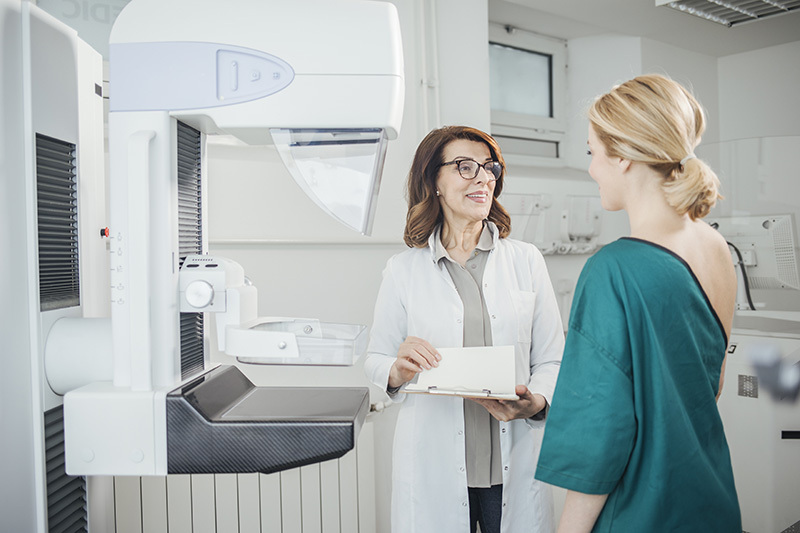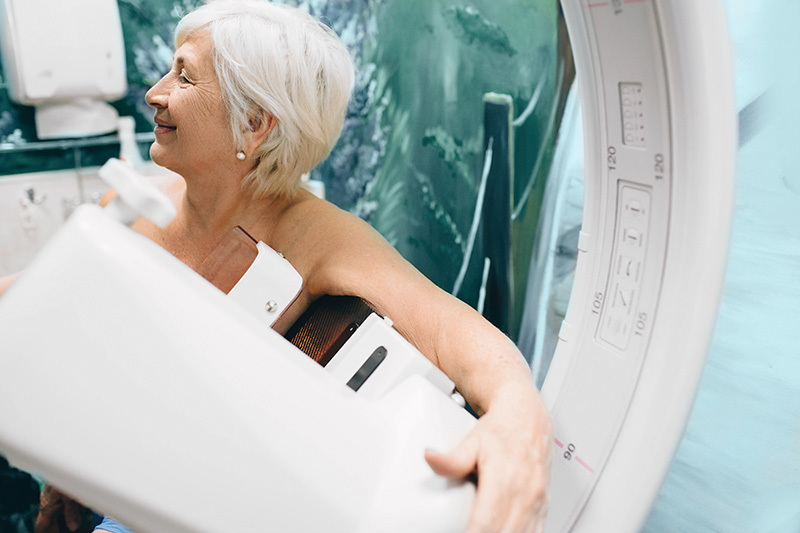Attention GCI Patients — Effective October 6, 2025, the GCI Oak Lawn location will be closed. All patients of GCI Oak Lawn will be seen at our Chicago Ridge location at 10604 Southwest Highway, Suite 109, Chicago Ridge, IL 60415.
Your doctor can check for breast cancer before you have any symptoms. During an office visit, your doctor will ask about your personal and family medical history. You’ll have a physical exam. Your doctor may order one or more imaging tests, such as a mammogram.
Doctors recommend that women have regular clinical breast exams and mammograms to find breast cancer early. Treatment is more likely to work well when breast cancer is detected early.
Clinical Breast Exam
During a clinical breast exam, your health care provider checks your breasts. You may be asked to raise your arms over your head, let them hang by your sides, or press your hands against your hips.
Your health care provider looks for differences in size or shape between your breasts. The skin of your breasts is checked for a rash, dimpling, or other abnormal signs. Your nipples may be squeezed to check for fluid.
Using the pads of the fingers to feel for lumps, your health care provider checks your entire breast, underarm, and collarbone area. A lump is generally the size of a pea before anyone can feel it. The exam is done on one side and then the other. Your health care provider checks the lymph nodes near the breast to see if they are enlarged.
If you have a lump, your health care provider will feel its size, shape, and texture. Your health care provider will also check to see if the lump moves easily. Benign lumps often feel different from cancerous ones. Lumps that are soft, smooth, round, and movable are likely to be benign. A hard, oddly shaped lump that feels firmly attached within the breast is more likely to be cancer, but further tests are needed to diagnose the problem.
Mammogram
A mammogram is an x-ray picture of tissues inside the breast. Mammograms can often show a breast lump before it can be felt. They also can show a cluster of tiny specks of calcium. These specks are called microcalcifications. Lumps or specks can be from cancer, precancerous cells, or other conditions. Further tests are needed to find out if abnormal cells are present.
Before they have symptoms, women should get regular screening mammograms to detect breast cancer early:
- Women in their 40s and older should have mammograms every 1 or 2 years.
- Women who are younger than 40 and have risk factors for breast cancer should ask their health care provider whether to have mammograms and how often to have them.

If the mammogram shows an abnormal area of the breast, your doctor may order clearer, more detailed images of that area. Doctors use diagnostic mammograms to learn more about unusual breast changes, such as a lump, pain, thickening, nipple discharge, or change in breast size or shape. Diagnostic mammograms may focus on a specific area of the breast. They may involve special techniques and more views than screening mammograms.
If you've recently had a mammogram and were told you have dense breasts, you probably have some questions about what this means and how it affects your breast cancer risks and future screenings. While dense breast tissue is common and may never cause additional problems, it can contribute to the need for additional testing in order for your doctor to get an accurate screening for breast cancer.

Other Imaging Tests
If an abnormal area is found during a clinical breast exam or with a mammogram, the doctor may order other imaging tests:
- Ultrasound: A woman with a lump or other breast change may have an ultrasound test. An ultrasound device sends out sound waves that people can’t hear. The sound waves bounce off breast tissues. A computer uses the echoes to create a picture. The picture may show whether a lump is solid, filled with fluid (a cyst), or a mixture of both. Cysts usually are not cancer. But a solid lump may be cancer.
- MRI: MRI uses a powerful magnet linked to a computer. It makes detailed pictures of breast tissue. These pictures can show the difference between normal and diseased tissue.
Biopsy
A biopsy is the removal of tissue to look for cancer cells. A biopsy is the only way to tell for sure if cancer is present.
You may need to have a biopsy if an abnormal area is found. An abnormal area may be felt during a clinical breast exam but not seen on a mammogram. Or an abnormal area could be seen on a mammogram but not be felt during a clinical breast exam. In this case, doctors can use imaging procedures (such as a mammogram, an ultrasound, or MRI) to help see the area and remove tissue.
Your doctor may refer you to a surgeon or breast disease specialist for a biopsy. The surgeon or doctor will remove fluid or tissue from your breast in one of several ways:
- Fine-needle aspiration biopsy: Your doctor uses a thin needle to remove cells or fluid from a breast lump.
- Core biopsy: Your doctor uses a wide needle to remove a sample of breast tissue.
- Skin biopsy: If there are skin changes on your breast, your doctor may take a small sample of skin.
- Surgical biopsy: Your surgeon removes a sample of tissue.
- An incisional biopsy takes a part of the lump or abnormal area.
- An excisional biopsy takes the entire lump or abnormal area.
A pathologist will check the tissue or fluid removed from your breast for cancer cells. If cancer cells are found, the pathologist can tell what kind of cancer it is. The most common type of breast cancer is ductal carcinoma. It begins in the cells that line the breast ducts. Lobular carcinoma is another type. It begins in the lobules of the breast.
Lab Tests with Breast Tissue
If you are diagnosed with breast cancer, your doctor may order special lab tests on the breast tissue that was removed:
- Hormone receptor tests: Some breast tumors need hormones to grow. These tumors have receptors for the hormones estrogen, progesterone, or both. If the hormone receptor tests show that the breast tumor has these receptors, then hormone therapy is most often recommended as a treatment option. See the Hormone Therapy section.
- HER2/neu test: HER2/neu protein is found on some types of cancer cells. This test shows whether the tissue either has too much HER2/neu protein or too many copies of its gene. If the breast tumor has too much HER2/neu, then targeted therapy may be a treatment option. See the Targeted Therapy section.
It may take several weeks to get the results of these tests. The test results help your doctor decide which cancer treatments may be options for you.
Breast Cancer Treatment Available in South Chicago
If you or a loved one received a breast cancer diagnosis, our care team is here to help. We offer personalized treatment plans and second opinions on diagnosis and treatment options. Find an oncologist near you in South Chicago, including Chicago Ridge, Mokena, Hazel Crest, Palos Heights, and Oak Lawn.